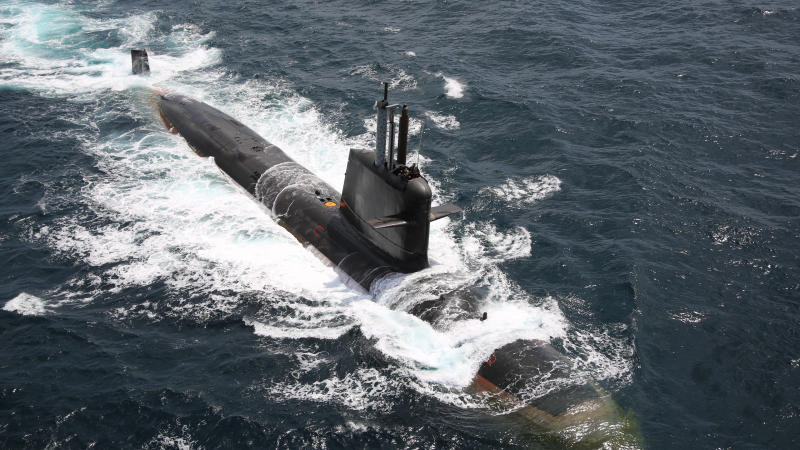Published 17:50 IST, October 22nd 2024
India Quietly Launches 4th Nuclear-Powered Ballistic Missile Submarine Countering Chinese Navy
India has launched its fourth nuclear-powered ballistic missile submarine (SSBN), codenamed S4*, at the Ship Building Centre in Visakhapatnam.

Visakhapatnam, India – In a move aimed at strengthening its nuclear deterrence against regional adversaries, India quietly launched its fourth nuclear-powered ballistic missile submarine (SSBN), codenamed S4*, at the Ship Building Centre (SBC) in Visakhapatnam this week. This significant milestone in India's strategic naval capabilities came amid rising diplomatic tensions with Canada but was carried out without fanfare, reflecting the country's discreet approach to its nuclear submarine program.
The launch of the S4* SSBN on October 16, 2024, is the latest addition to India’s growing fleet of nuclear-powered submarines, which are vital to maintaining a credible second-strike capability. The SSBN fleet is integral to India’s nuclear deterrence strategy, particularly in the Indo-Pacific, where adversaries like China and Pakistan are seen as strategic threats.
This development follows the commissioning of India’s second SSBN, INS Arighat, by Defence Minister Rajnath Singh on August 29, 2024, and comes ahead of the scheduled commissioning of the third SSBN, INS Aridhaman, in 2025. These submarines, with their ability to remain submerged for extended periods, are key assets in providing an assured retaliatory strike capability, which is critical for nuclear deterrence.
Modi Government’s Focus on Nuclear Deterrence
While the Modi government has maintained a tight-lipped stance on nuclear deterrence matters, the launch of the S4* underscores India's commitment to bolstering its sea-based nuclear capabilities. The launch took place just a day after Defence Minister Rajnath Singh inaugurated the Very Low-Frequency Naval Station in the Damagundam forest area of Vikarabad district in Telangana. This station enhances command, control, and communication with the Indian Navy's strategic assets, reinforcing India's maritime strategic architecture.

The S4* SSBN boasts nearly 75% indigenous content and is equipped with 3,500 km range K-4 nuclear ballistic missiles, which can be launched through vertical launching systems. Unlike India’s first SSBN, INS Arihant, which carries 750 km range K-15 missiles, the newer submarines have been significantly upgraded to carry only K-4 ballistic missiles, enhancing India’s strike range and operational flexibility. With unlimited range and endurance, the SSBN’s constraints are limited only by factors like food supplies, crew fatigue, and maintenance requirements.
A Growing Submarine Fleet
India’s SSBN program follows a strategic lineage. The first nuclear-powered attack submarine India leased from Russia, INS Chakra, was classified as S1, with subsequent SSBNs—INS Arihant (S2), INS Arighat (S3), and INS Aridhaman (S4)—following this convention. The newly launched S4* represents the last of its class, with its formal name yet to be given.

India’s next class of SSBNs will feature significantly larger submarines, double the 6,000-ton displacement of the Arihant class, capable of carrying nuclear missiles with ranges upwards of 5,000 kilometres. These advancements highlight India’s focus on improving its sea-based deterrent against powerful adversaries such as China, particularly as aircraft carriers remain vulnerable to China’s long-range missiles, like the Dong Feng-21 and Dong Feng-26. The government has therefore prioritized the development of nuclear-powered ballistic missile submarines over the construction of a third aircraft carrier for the Indian Navy.
In addition to the nuclear submarine program, India is also strengthening its conventional submarine deterrence. The sixth of the diesel-powered Kalvari class submarines, INS Vaghsheer, is set to be commissioned in December 2024, adding another layer to India's maritime defences. Plans for constructing three more advanced diesel attack submarines at Mazagon Dockyards in collaboration with the French Naval Group are also in progress. These submarines are expected to further enhance India's maritime capabilities in the coming years.
Countering Growing PLA Naval Presence
India’s push to develop its strategic and conventional submarine fleet comes in response to an increasing presence of PLA warships in the Indian Ocean. Since 2023, the Chinese People's Liberation Army Navy (PLAN) has maintained a near-constant deployment of 10-11 warships in the Indian Ocean Region (IOR), a trend that is expected to intensify with carrier-based long-range patrols in 2025-26.

The Indian Navy’s strategic submarines will play a pivotal role in defending India’s maritime interests and in countering China’s growing naval footprint in the region. The quiet launch of the S4* SSBN underscores India’s determination to fortify its sea-based nuclear deterrent amid increasing strategic challenges in the Indo-Pacific. With a growing fleet of nuclear-powered and conventional submarines, India is positioning itself to defend its national security interests and maintain dominance in the IOR.
Updated 17:50 IST, October 22nd 2024




